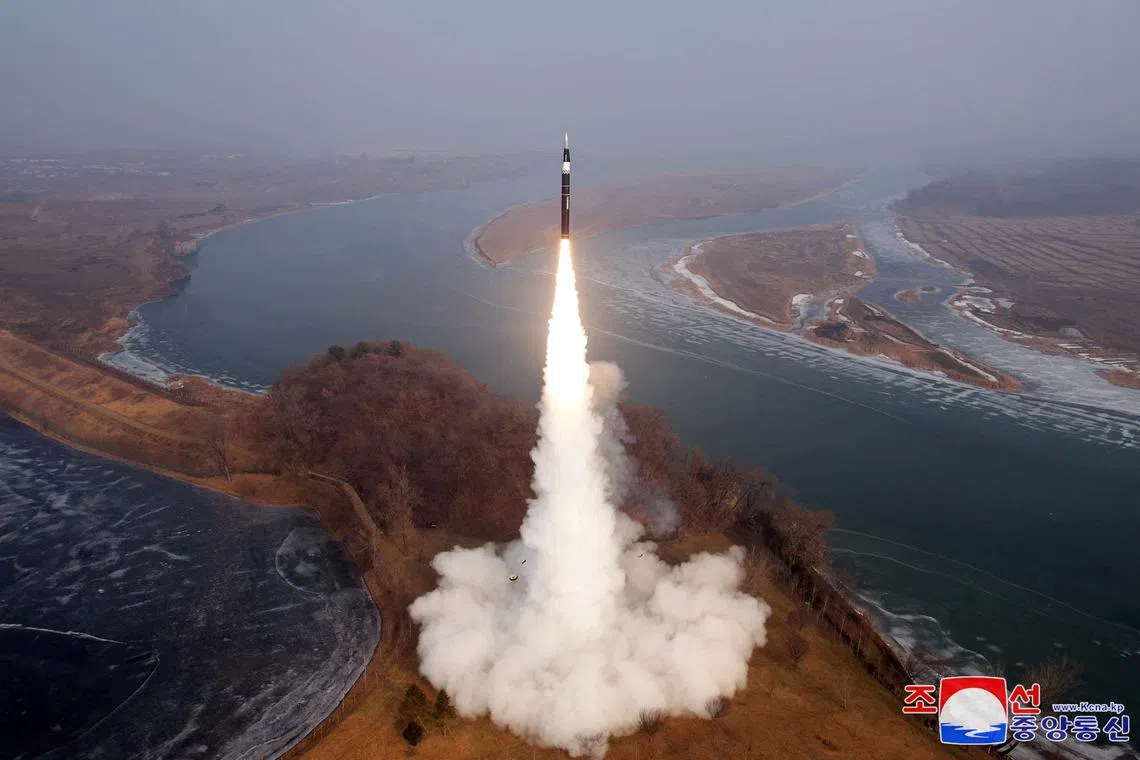North Korea successfully tests new intermediate-range missile, state media says
Sign up now: Get insights on Asia's fast-moving developments

The test-launch of North Korea's new intermediate-range hypersonic ballistic missile took place in the outskirts of Pyongyang on Jan 6, according to state media KCNA.
PHOTO: REUTERS
Follow topic:
SEOUL – North Korean leader Kim Jong Un oversaw a successful test of a new intermediate-range hypersonic ballistic missile (IRBM) on Jan 6, state media KCNA said on Jan 7, as the country raced to advance its nuclear and missile capabilities.
It was North Korea’s first missile launch since Nov 5 and coincided with a visit by US Secretary of State Antony Blinken to South Korea
The test occurred less than two weeks before US President-elect Donald Trump, who held unprecedented summits with Mr Kim during his first term and has touted their personal rapport, returns to office.
The missile was fired in the outskirts of Pyongyang and flew some 1,500km at 12 times the speed of sound, reaching an altitude of nearly 100km before descending to a “second peak” of 42.5km and manoeuvring to an accurate landing on a target off the east coast, KCNA said.
South Korea’s military said the KCNA report was most likely exaggerated, estimating the range at around 1,100km and saying there was no second peak detected, although detailed analysis would be conducted with the United States.
A second peak would imply that the missile could change course and maintain altitude rather than descending on a ballistic trajectory.

People in Seoul watching a TV news report on North Korea firing a ballistic missile out to sea off its east coast on Jan 6.
PHOTO: REUTERS
New carbon fibre composite materials were used in the missile’s engine, KCNA said. Carbon fibre is lighter and stronger than other aerospace materials such as aluminium, but is more difficult to manufacture.
KCNA said the missile could “effectively penetrate any dense defence barrier and inflict a serious military blow on the opponent”.
Mr Kim hailed the missile as a powerful weapon to cope with security threats posed by hostile forces and the changing regional security environment.
KCNA released photos of Mr Kim monitoring the launch via teleconference alongside his young daughter, and a missile lifting off from a field.
“The development of the new-type hypersonic missile is mainly aimed to steadily put the country’s nuclear war deterrent on an advanced basis,” he said, according to KCNA.
Mr Blinken and South Korean Foreign Minister Cho Tae-yul condemned the launch, and warned of Pyongyang’s deepening ties with Moscow, including illicit cooperation on space and satellite technology.
North Korea has been developing a new solid-fuel hypersonic IRBM amid an intensifying race for the next generation of long-range rockets that are difficult to track and intercept.
Tests in 2024 featured a new solid-fuel design and carried what Pyongyang said was a hypersonic glide vehicle, a warhead designed to be able to manoeuvre and evade missile defences.
Colonel Lee Sung-jun, a spokesman for South Korea’s military, said that the latest launch appeared to be an extension of 2024’s test. REUTERS

